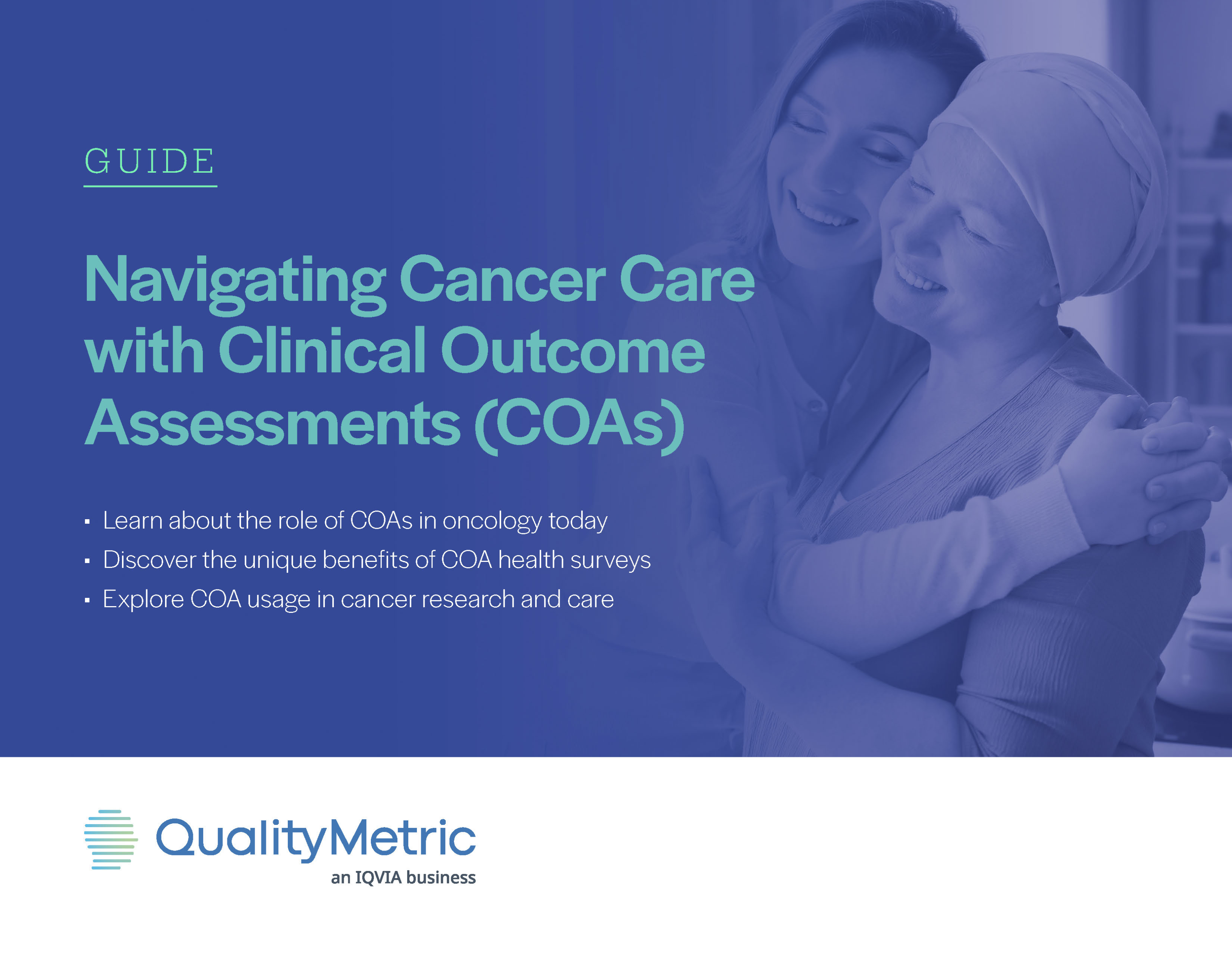
Navigating the regulatory process to build product label and marketing claims can be difficult, especially when it comes to selecting endpoints that generate the right type of evidence to support those claims. For this reason selecting the right patient-reported outcome (PRO) instrument is essential to whether for new treatments, therapeutics or medical devices, regulatory efforts require a strategic approach to endpoint implementation, instrument measurement and qualitative and quantitative research.
The field of rare diseases in particular suffers from a severe lack of instruments available to facilitate necessary studies. But clinical outcome assessments (COAs)—patient-reported outcomes (PROs) in particular—have become a viable solution for teams across many therapeutic areas looking to source usable patient data and conduct research with patient-centric designs.

Patient-reported outcome measures are gaining traction as invaluable tools in the regulatory phase of medical device development. This type of COA captures data straight from patients through self-directed surveys that can assess quality of life, functional health and well-being for a variety of diseases, conditions, treatments and care programs. With electronic devices like smartphones and tablets, patients are able to communicate their symptoms and unique experiences with healthcare products and supply researchers with the real-world evidence to inform product safety and efficacy.
The Food and Drug Administration asserts PRO instruments enable the systematic collection of real patient perspectives for use as valid scientific evidence supporting the regulatory and healthcare decision-making process. New FDA guidance also encourages integrating patient-reported outcomes in the development, evaluation and surveillance of medical device studies. For medical device manufacturers, determining the optimal measurement strategy for a study may involve specifying a PRO instrument, modifying an existing one or developing an entirely new PRO to meet the goals of a trial.

Selecting the Right PRO for Your Medical Device Study
Capturing patient perspectives during the evaluation of medical devices is an integral step for FDA approval. Ensuring you have the right PRO is essential to providing evidence of patient experience and quality of life. Consider some of the following when selecting the right PRO for your medical device evaluation:
- Validity and reliability: FDA expectations are to have a scientifically validated PRO that can demonstrate psychometric analysis for the intended use in the medical device evaluation.
- Study design: The selected PRO survey should be an integral part of the clinical investigation, this may include collection of PRO data during the clinical trial. Additionally, the study design should ensure the right sample size or patient population to provide meaningful PRO data.
- Outcome measurement: Baseline and follow-up assessments should be provided to study participants at relevant time points during the medical device evaluation. Allowing for both short- and long-term effects to be captured by the patient. Longitudinal PRO data collection provides insights into patients’ experiences and burden of disease throughout the disease condition.
- Data analysis and interpretation: Once the data has been collected it is essential to ensure algorithm scoring is done accurately. The results should convey benefits and quality of life improvements in the context of the clinical data for a thorough understanding of the medical devices benefits and risks.
Recent FDA guidance aims to ensure medical device regulation is led through patient-centered evaluations. Selecting a PRO company with legacy PRO surveys and scientific expertise in the regulatory field will enable medical device companies to provide valuable information for regulatory decision-making. QualityMetric offers legacy PRO surveys, such as the SF-36v2, and scientific expertise to ease the regulatory process throughout the clinical phases.
Accelerating Regulatory Approval with PROs
With the help of PROs and experienced COA providers, research teams can align product designs with patient values, interests and preferences and explore the effects of real-time product lifecycle decisions. Patient-reported outcome instruments are scientifically rigorous methods of giving patients a voice during studies and input on what successful clinical trials actually look like. This leads to the development of drugs and devices that patients find useful and worthy of their trust.
PROs are ideal for an array of regulatory-related applications:

To fast-track the success of research projects, QualityMetric offers expert guidance on regulatory compliance for every element of chosen PRO instruments, from design and implementation to analysis and interpretation. Our scientists have formed solid relationships with global regulatory agencies and leading professional societies and possess an extensive understanding of regulatory processes and guidelines in the U.S. and other markets around the globe.

QualityMetric has facilitated the approval of over a hundred label claims and continues to provide both tools and support to organizations through a range of regulatory services, including:
 Developing and reviewing regulatory communications and meeting packages, COA evidence dossiers and label claim language for regulatory submission
Developing and reviewing regulatory communications and meeting packages, COA evidence dossiers and label claim language for regulatory submission
 Preparing, attending and participating in FDA meetings, such as End-of-Phase 2, Type B and Type C meetings
Preparing, attending and participating in FDA meetings, such as End-of-Phase 2, Type B and Type C meetings
 Engaging strategically and tactically with FDA staffers from CBER, CDER and CDRH, including the COA group and clinical review divisions
Engaging strategically and tactically with FDA staffers from CBER, CDER and CDRH, including the COA group and clinical review divisions
Our regulatory insights help establish an effective approach to gathering evidence of product safety and efficacy, gaining marketing and clinical trial authorizations and strengthening success in post-licensing and post-marketing efforts. And with a suite of disease-specific and generic PRO health surveys available in more than 2,000 linguistically validated translations across various modes of administrations, teams are sure to find an instrument that will make all the difference in their regulatory and compliance initiatives.
Get in touch with QualityMetric for more information about our COA solutions, licensing services and scientific consulting capabilities.
 NEW COAS IN ONCOLOGY GUIDE
NEW COAS IN ONCOLOGY GUIDE




